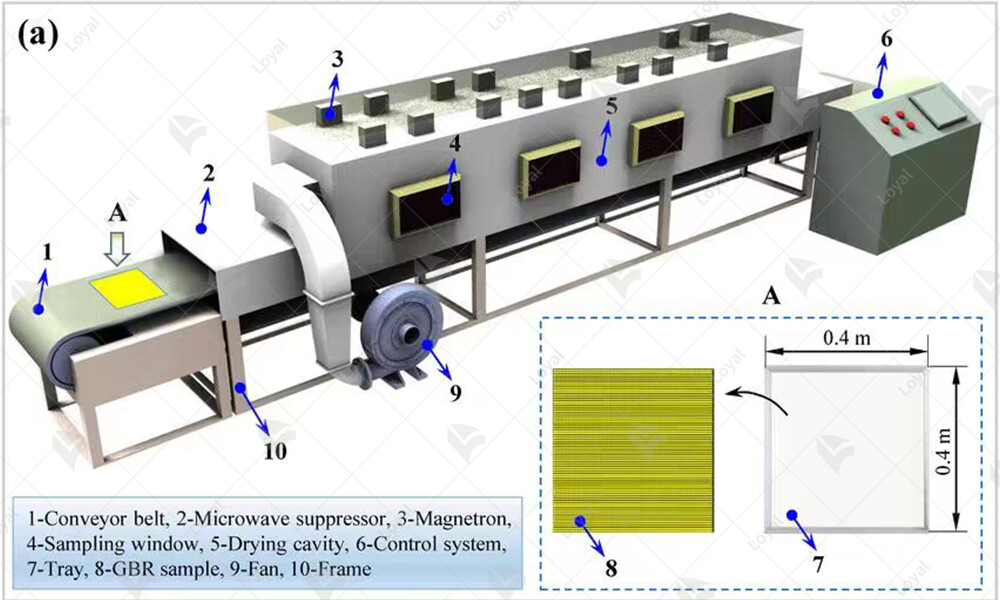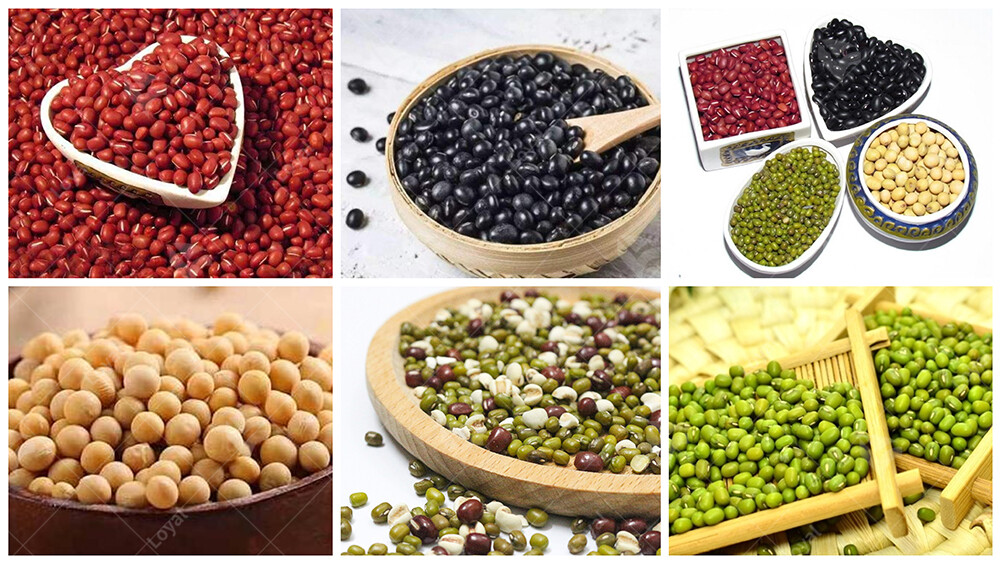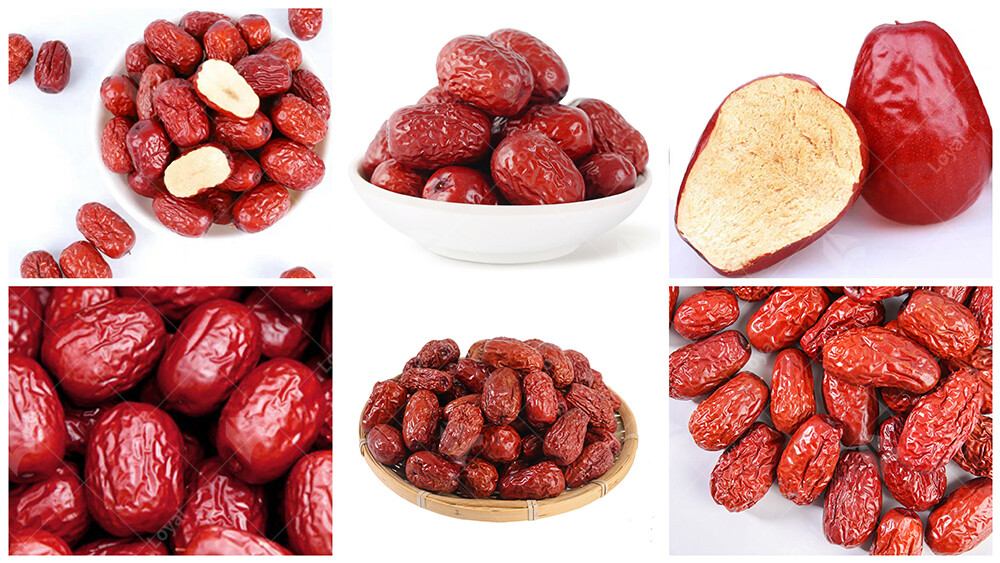The Ultimate Guide to Industrial Microwave Drying Machine in 2024
Introduction
In the realm of industrial processing, the utilization of cutting-edge technologies has become pivotal to enhance efficiency and productivity. Among these technologies, industrial microwave drying machines stand out as a transformative force, revolutionizing the way various materials are dried across industries. As we navigate through 2024, the significance of these machines only amplifies, paving the path for unprecedented advancements and applications. This ultimate guide delves deep into the realm of industrial microwave drying machines, elucidating their principles, applications, and the transformative impact they hold within the industrial landscape.

Working principle
The working principle of an industrial microwave drying machine revolves around harnessing the power of electromagnetic waves to efficiently remove moisture from various materials. Unlike conventional drying methods which rely on convection or conduction, industrial microwave drying utilizes microwave radiation to penetrate the material and excite water molecules, causing them to oscillate rapidly. This agitation generates heat within the material itself, leading to rapid evaporation of moisture. The key to effective microwave drying lies in the careful control of frequency, power, and duration, ensuring optimal drying while minimizing energy consumption and preserving product quality. By harnessing the power of microwaves, industrial microwave drying machines offer a faster, more uniform, and energy-efficient drying solution for a wide range of applications across industries.

Advantages of industrial microwave dryer
Advantage | Explanation |
Rapid Heating | Industrial microwave dryers utilize electromagnetic waves to rapidly heat materials, reducing drying time significantly. This speed is crucial for industries requiring quick turnaround times. |
Uniform Heating | Unlike traditional drying methods which often result in uneven drying, industrial microwave dryers provide uniform heating throughout the material, ensuring consistent quality. |
Energy Efficiency | Industrial microwave dryers are highly energy-efficient, as they directly heat the material rather than heating the surrounding environment. This reduces energy wastage and operational costs. |
Reduced Risk of Contamination | Microwave drying minimizes the risk of contamination compared to conventional drying methods, as there's no contact with potentially contaminated surfaces or materials. This is vital for industries with stringent hygiene standards. |
Preservation of Nutrients and Flavor | The precise and controlled heating of industrial microwave dryers helps preserve the nutrients, texture, and flavor of the material being dried, making it ideal for food processing applications. |
Versatility | Industrial microwave dryers are versatile and can be used for drying a wide range of materials, including food products, pharmaceuticals, chemicals, and more. Their adaptability makes them suitable for diverse industrial applications. |
Compact Design | Many industrial microwave dryers feature a compact design, requiring minimal floor space compared to traditional drying equipment. This space-saving feature is advantageous for facilities with limited space. |
Environmental Sustainability | Microwave drying produces fewer greenhouse gas emissions compared to other drying methods, contributing to environmental sustainability. Additionally, its energy efficiency helps reduce overall carbon footprint. |

Comparison and advantages of microwave technology and traditional drying methods
Aspect | Microwave Drying Technology | Traditional Drying Methods |
Heating Mechanism | Utilizes electromagnetic waves to directly heat the material, leading to faster and more uniform drying. | Relies on convection, conduction, or radiation to transfer heat to the material, often resulting in uneven drying and longer processing times. |
Energy Efficiency | Significantly higher energy efficiency due to direct heating, reducing overall drying time and energy consumption. | Lower energy efficiency compared to microwave drying, as heat transfer mechanisms may lead to energy loss and inefficiencies. |
Drying Time | Shorter drying cycles, typically 30% to 50% faster than traditional methods, leading to increased production throughput. | Longer drying times due to indirect heating methods, which may extend processing schedules and decrease overall productivity. |
Product Quality | Preserves product quality by maintaining moisture content and preventing over-drying or thermal degradation. | May compromise product quality due to uneven drying and exposure to higher temperatures, leading to texture changes or loss of nutritional value. |
Environmental Impact | Reduced environmental footprint with lower energy consumption and emissions, aligning with sustainability goals. | Higher environmental impact due to greater energy usage and potential emissions from combustion processes in traditional drying systems. |
Flexibility and Control | Offers precise control over drying parameters such as temperature, humidity, and power levels, allowing for tailored drying processes. | Limited control over drying conditions, with fewer options for customization and optimization of drying parameters. |
Space and Installation | Compact and versatile design, requiring less floor space and offering ease of installation and integration into existing production lines. | Often larger and more cumbersome systems, requiring dedicated space and extensive installation procedures. |
Application Versatility | Suitable for a wide range of materials, including heat-sensitive products, powders, granules, and bulk solids. | Limited applicability for certain materials or products sensitive to high temperatures or prolonged drying times. |

Types of industrial microwave dryers
1. Batch Industrial Microwave Dryers:
Batch industrial microwave dryers are designed for smaller-scale operations or products that require individual attention. These machines allow for precise control over drying parameters, making them suitable for products with specific moisture content requirements or delicate compositions. Batch dryers are versatile and can accommodate various product sizes and shapes, making them ideal for research and development purposes or specialized applications.
2. Continuous Industrial Microwave Dryers:
Continuous industrial microwave dryers are engineered for high-volume production processes that demand uninterrupted drying operations. Unlike batch dryers, continuous dryers feature a conveyor belt or other continuous feeding mechanisms, allowing for a steady flow of products through the drying chamber. These systems are highly efficient, maximizing throughput while maintaining consistent drying quality. Continuous dryers are favored in industries such as food processing, where large quantities of products need to be dried quickly and uniformly.
3. Hybrid Industrial Microwave Dryers:
Hybrid industrial microwave dryers combine microwave technology with conventional drying methods, such as hot air convection or infrared radiation. This hybrid approach leverages the benefits of both technologies, resulting in faster drying times, improved energy efficiency, and enhanced product quality. By integrating multiple drying techniques, hybrid dryers offer greater flexibility and control over the drying process, making them suitable for a wide range of applications across industries.

Technical parameters
| Technical Parameters Of Continuous Microwave Dryer Industrial Microwave Drying Machine | |||||
| Model | Size LWH(Can be customized according to the customer's requirements) | Output power | Dewaterability | Sterilization capacity | Baking and Roasting capacity (Depends on different raw material) |
| LY-10KW | 5000mm825mm1750mm | ≥10KW | 10KG/Hour | 100KG/Hour | 30-50KG/Hour |
| LY-20KW | 8000mm825mm1750mm | ≥20KW | 20KG/Hour | 200KG/Hour | 60-100KG/Hour |
| LY-30KW | 8500mm1160mm1750mm | ≥30KW | 30KG/Hour | 300KG/Hour | 90-150 KG/Hour |
| LY-40KW | 10000mm1160mm1750mm | ≥40KW | 40KG/Hour | 40KG/Hour | 120-200KG/Hour |
| LY-50KW | 12500mm1160mm1750mm | ≥50KW | 50KG/Hour | 500KG/Hour | 150-250KG/Hour |
| LY-60KW | 13500mm1450mm1750mm | ≥60KW | 60KG/Hour | 600KG/Hour | 180-300KG/Hour |
| LY-70KW | 13500mm1500mm1750mm | ≥70KW | 70KG/Hour | 700KG/Hour | 210-350KG/Hour |
| LY-80KW | 13500mm1650mm1750mm | ≥80KW | 80KG/Hour | 800KG/Hour | 240-400KG/Hour |
| LY-100KW | 16800mm1650mm1750mm | ≥100KW | 100KG/Hour | 1000KG/Hour | 300-500KG/Hour |
| LY-150KW | 22400mm1850mm1750mm | ≥150KW | 150KG/Hour | 1500KG/Hour | 450-750KG/Hour |
| LY-200KW | 27000mm1850mm1750mm | ≥250KW | 250KG/Hour | 2500KG/Hour | 750-1250/Hour |
| LY-300KW | 32000mm1850mm1750mm | ≥300KW | 300KG/Hour | 3000KG/Hour | 900-1500KG/Hour |
| Power Supply | 380V±10% 50Hz±1% Three-Phase Five-Wire | ||||
| Microwave Output Frequency | 2450±50Mhz | ||||
| Microwave Input Apparent Power | ≤168Kva | ||||
| Microwave Output Power | ≥120Kw | ||||
| Microwave Power Adjustment Range | 0-30Kw(Adjustable) | ||||
| Ambient Temperature | -5-40°C | ||||
| Relative Humidity | ≤80%, Surrounding Environment:No Corrosive Gas, Conductive Dust And Explosive Gas | ||||
| Transmission Speed | 0-10m/Min(Adjustable) | ||||

Application of industrial microwave dryers
Food Industry:
One of the primary domains benefiting from industrial microwave drying machines is the food industry. These machines offer a rapid and uniform drying process, preserving the nutritional content, flavor, and texture of food products. From fruits and vegetables to meats and seafood, industrial microwave dryers ensure high-quality end products with extended shelf life. Moreover, their ability to reduce drying time significantly enhances productivity and reduces energy consumption compared to conventional drying methods.
Pharmaceuticals:
In the pharmaceutical sector, precision and consistency are paramount. Industrial microwave drying machines facilitate the drying of pharmaceutical products such as powders, granules, and herbs with utmost accuracy. By maintaining strict temperature control and minimizing exposure to external contaminants, these dryers ensure the integrity and efficacy of pharmaceutical formulations. Additionally, their rapid drying capabilities contribute to streamlined production processes, ultimately reducing operational costs and time-to-market for new medications.
Chemical Industry:
Industrial microwave drying machines play a crucial role in the chemical industry by enabling the efficient drying of various chemical compounds, catalysts, and intermediates. Their ability to penetrate materials uniformly and generate heat from within results in faster drying times and enhanced product quality. Furthermore, these machines offer precise control over temperature and moisture levels, minimizing the risk of degradation or alteration of chemical properties. As a result, manufacturers benefit from increased productivity, reduced waste, and improved overall product consistency.
Textile Sector:
In the textile sector, industrial microwave drying machines have emerged as a game-changer, particularly in the processing of fabrics, yarns, and garments. Traditional drying methods often lead to uneven drying and shrinkage, compromising the quality of textile products. However, industrial microwave dryers address these challenges by delivering uniform and gentle drying, thus preserving the integrity and appearance of textiles. Whether it's cotton, wool, or synthetic fibers, these machines offer precise control over moisture removal, resulting in softer, smoother, and more resilient textiles.

Precautions for Selection and Implementation of Industrial Microwave Dryers
Industrial microwave drying machines have revolutionized various sectors by offering efficient and rapid drying solutions. As we navigate through 2024, understanding the nuances of selecting and implementing these machines becomes paramount. Below are essential precautions to consider:
1. Technological Compatibility:
Ensure the chosen industrial microwave drying machine aligns with your technological infrastructure. Assess compatibility with existing systems and the potential for integration. Opt for models offering seamless connectivity and control options, facilitating streamlined operations.
2. Material Specificity:
Different materials exhibit varied responses to microwave drying. Prioritize machines equipped with adjustable parameters to accommodate diverse materials. Conduct thorough material assessments to determine compatibility and optimize drying outcomes. Consult with industry experts to ascertain the most suitable machine for your specific materials.
3. Energy Efficiency:
In the pursuit of sustainable practices, prioritize energy-efficient industrial microwave drying machines. Evaluate energy consumption metrics and inquire about eco-friendly features such as energy recovery systems. Opting for energy-efficient models not only reduces operational costs but also minimizes environmental impact.
4. Safety Protocols:
Maintaining stringent safety standards is imperative when implementing industrial microwave drying machines. Prioritize models equipped with comprehensive safety features such as automated shutdown mechanisms and temperature monitoring systems. Additionally, invest in employee training programs to ensure adherence to safety protocols during operation.
5. Quality Assurance:
Selecting reputable manufacturers renowned for quality craftsmanship is essential. Thoroughly vet manufacturers' credentials, certifications, and track records to ascertain reliability and product excellence. Prioritize machines backed by robust warranties and comprehensive after-sales support to safeguard against potential malfunctions.
6. Regulatory Compliance:
Adherence to industry regulations and standards is non-negotiable. Ensure selected industrial microwave drying machines comply with relevant regulatory frameworks and safety guidelines. Stay abreast of evolving regulations to preemptively address compliance requirements and mitigate potential legal ramifications.
7. Operational Optimization:
Maximize the utility of industrial microwave drying machines through operational optimization strategies. Implement routine maintenance schedules and calibration routines to uphold machine performance and longevity. Additionally, foster a culture of innovation and continuous improvement to explore novel applications and enhance operational efficiency.
In conclusion, the selection and implementation of industrial microwave drying machines demand meticulous attention to detail and adherence to best practices. By prioritizing technological compatibility, material specificity, energy efficiency, safety protocols, quality assurance, regulatory compliance, and operational optimization, organizations can leverage these machines to unlock unparalleled drying capabilities and propel their operations forward in 2024 and beyond.

Challenges and Limitations of Industrial Microwave Dryers
In 2024, the industrial landscape continues to evolve with advancements in technology, particularly in the realm of industrial microwave drying machines. These innovative devices have revolutionized various sectors by offering rapid and efficient drying solutions. However, despite their numerous benefits, industrial microwave dryers are not without their challenges and limitations.
1. Uniformity of Drying:
One of the primary challenges faced by industrial microwave drying machines is achieving uniform drying throughout the product. Microwave energy tends to penetrate the surface of the material, leading to uneven drying rates. This non-uniform drying can result in product inconsistency and quality issues.
2. Material Compatibility:
Another significant limitation of industrial microwave dryers is their compatibility with certain materials. While they are highly effective for drying a wide range of products, including food, ceramics, and pharmaceuticals, some materials may be incompatible due to their composition or structure. For example, materials with high moisture content or dense compositions may require longer drying times or alternative drying methods.
3. Energy Consumption:
Despite being touted for their energy efficiency, industrial microwave drying machines still consume a considerable amount of power. The generation and distribution of microwave energy require substantial energy input, contributing to operational costs. Additionally, the need for precise control and monitoring systems adds to the overall energy consumption of these machines.
4. Equipment Cost:
Investing in industrial microwave drying equipment can be a significant financial commitment for businesses. The initial capital outlay for purchasing and installing these machines is often higher compared to conventional drying systems. Moreover, ongoing maintenance and repair costs can further escalate the total cost of ownership over time.
5. Safety Concerns:
Microwave radiation poses potential safety risks to operators and workers if proper precautions are not observed. While industrial microwave drying machines are equipped with safety features to minimize exposure to radiation, operators must adhere to strict safety protocols to prevent accidents and ensure a safe working environment.
6. Regulatory Compliance:
Compliance with regulatory standards and guidelines is essential for the operation of industrial microwave drying machines. Depending on the industry and geographical location, manufacturers must ensure that their equipment meets specific safety and quality standards set forth by regulatory authorities. Failure to comply with these regulations can result in fines, penalties, or legal repercussions.

References
The following are five authoritative foreign literature websites in the field of industrial microwaves:
1. IEEE Xplore Digital Library
Website: [https://ieeexplore.ieee.org/]
2.ScienceDirect
Website: [https://www.sciencedirect.com/]
3. SpringerLink
Website: [https://link.springer.com/]
4. Wiley Online Library
Website: [https://onlinelibrary.wiley.com/]
5. PubMed
Website: [https://pubmed.ncbi.nlm.nih.gov/]












